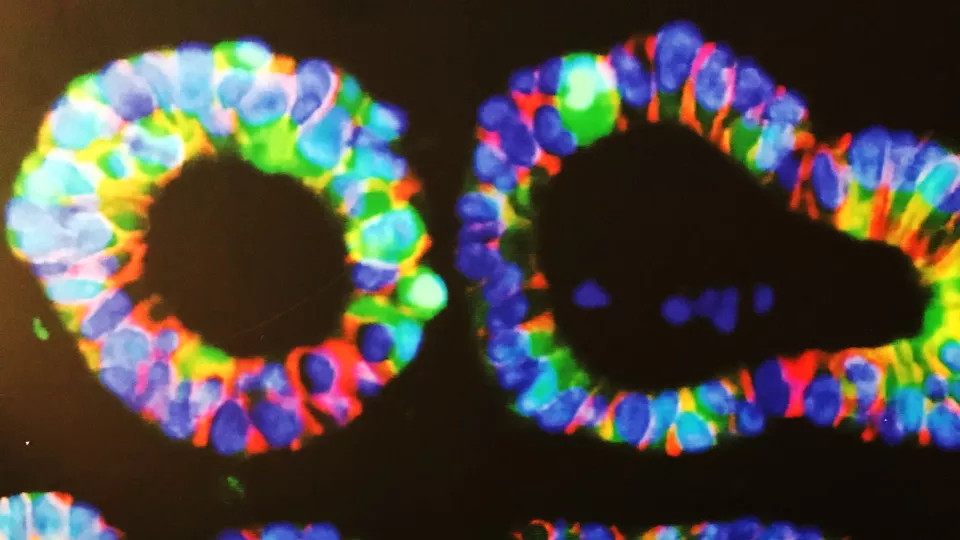
Tissue Engineering: The Big Picture on Growing Small Intestines
Babies born prematurely often face intense medical challenges, including intestines that are underdeveloped or diseased. While an intestine transplant can benefit some patients, many babies are simply too small to endure this procedure. Children’s Hospital Los Angeles surgeon Tracy Grikscheit, MD, is a leader in the field of tissue engineering – growing intestines from stem cells. In an article published in the journal Cell Stem Cell, Dr. Grikscheit and co-authors highlight how stem cell therapy is poised to become a game-changer for these babies.

Some premature babies are born with severely underdeveloped gastrointestinal tracts or can develop diseases like necrotizing enterocolitis, which attacks the intestines. In severe cases, surgical removal of the affected bowels (intestines) must be performed. This can have dire consequences.
Most nutrient and water absorption occurs in the small intestine, so if patients are not left with enough healthy tissue, they can suffer from serious complications like malnutrition or dehydration – also known as short bowel syndrome. In order to get the proper nutrients, patients may have to be fed through a feeding tube or intravenously- through a needle into the bloodstream. In the most severe cases of short bowel syndrome, small intestine transplant from donor tissue is the only answer; but this, too, comes with its own list of problems. Babies must be big enough for this procedure, which often means they need to wait several months. Even then, the road is not an easy one. Patients must take anti-rejection medications, which have their own side effects and the success rate of transplantation is only about fifty percent.
With such challenges, the future seems bleak for these babies. To Dr. Grikscheit, this is not acceptable. She wants more for her patients and she envisions a world in which missing portions of intestines can be grown.
Scientists like Dr. Grikscheit investigate growth of new tissue from stem cells to treat babies with severe intestinal impairments. “Stem cell therapies would really improve upon current options,” she says. “Right now, these babies can either get a transplant, or live on IV nutrition, which really impacts the way they can interact with the world and develop. There has to be a better way.”
The article in Cell Stem Cell was written by Dr. Grikscheit and colleagues as part of INTENS, a European consortium that fosters research to treat children with intestinal failure through tissue engineering. Tissue engineering is the process of producing new tissue in the laboratory from stem cells. The publication describes the progress researchers have made as well as the challenges scientists face in bringing stem cell therapy to patients.
Stem cells have the capability of developing into any cell type, making them ideal starting material for organ repair. The paper discusses two main ways in which stem cells could potentially treat babies with these intestinal issues. Stem cells can either be taken from the patient’s own intestine or “off the shelf” – from a stock source of stem cells that can be engineered into intestinal tissue. The two pathways each offer distinct advantages to patients and the treatment type could depend on the condition each child faces.
Research in this field is showing promise for future therapy. Recent progress has allowed researchers to generate larger amounts of intestinal tissue than ever before.
“We’re not yet at the stage of delivering this therapy to babies but we’re developing the road map,” says Dr. Grikscheit. “We’re getting closer.”
Co-senior authors of the article include Dr. Kim B. Jensen of the University of Copenhagen and Dr. Paolo De Coppi of Great Ormond Street Hospital and University College London. The INTENS consortium is supported by the Horizon 2020 research and innovation programme (668294).
Fluorescent image of intestinal stem and progenitor cells. Cells like these can grow into engineered intestinal tissue in the laboratory. Eventually, Dr. Grikscheit hopes engineered intestine can help babies born with severe gastrointestinal challenges.
About Children's Hospital Los Angeles
Children's Hospital Los Angeles has been ranked the top children's hospital in California and sixth in the nation for clinical excellence by the prestigious U.S. News & World Report Honor Roll. The Saban Research Institute at CHLA is one of the largest and most productive pediatric research facilities in the United States. CHLA also is one of America's premier teaching hospitals through its affiliation since 1932 with the Keck School of Medicine of the University of Southern California. For more, visit CHLA.org, the child health blog and the research blog.


